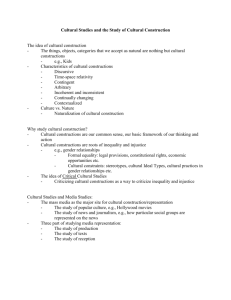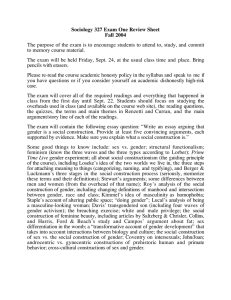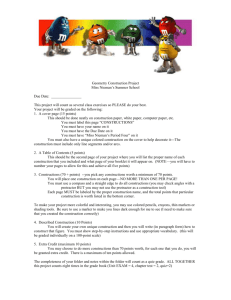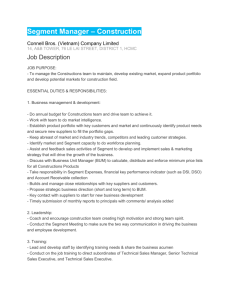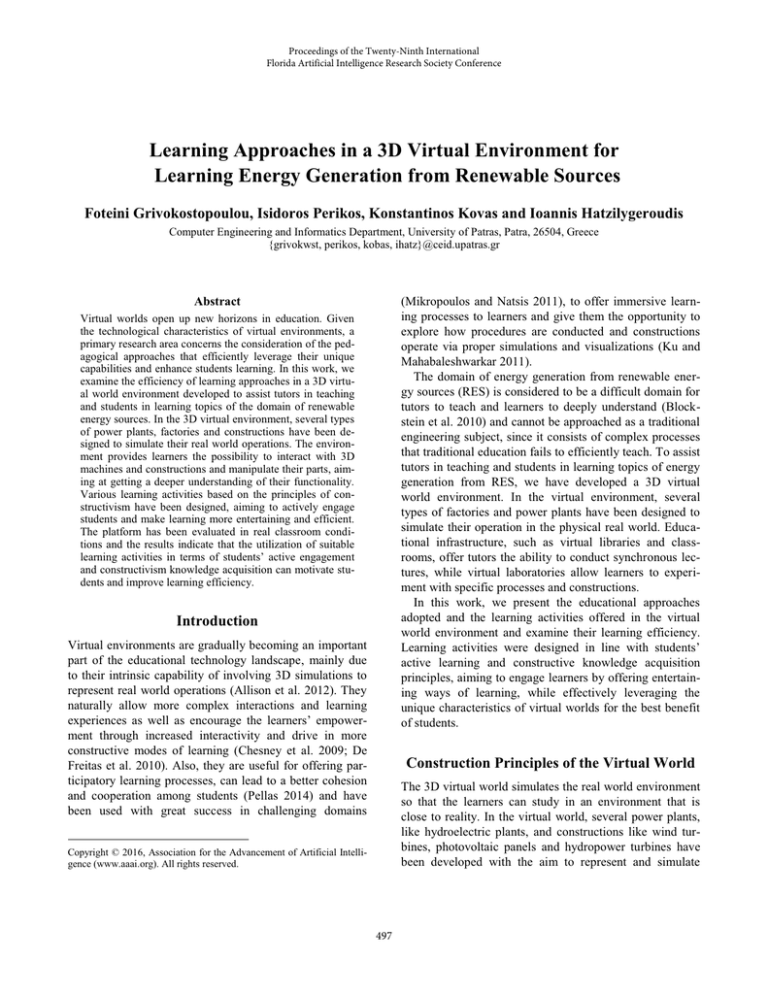
Proceedings of the Twenty-Ninth International
Florida Artificial Intelligence Research Society Conference
Learning Approaches in a 3D Virtual Environment for
Learning Energy Generation from Renewable Sources
Foteini Grivokostopoulou, Isidoros Perikos, Konstantinos Kovas and Ioannis Hatzilygeroudis
Computer Engineering and Informatics Department, University of Patras, Patra, 26504, Greece
{grivokwst, perikos, kobas, ihatz}@ceid.upatras.gr
(Mikropoulos and Natsis 2011), to offer immersive learning processes to learners and give them the opportunity to
explore how procedures are conducted and constructions
operate via proper simulations and visualizations (Ku and
Mahabaleshwarkar 2011).
The domain of energy generation from renewable energy sources (RES) is considered to be a difficult domain for
tutors to teach and learners to deeply understand (Blockstein et al. 2010) and cannot be approached as a traditional
engineering subject, since it consists of complex processes
that traditional education fails to efficiently teach. To assist
tutors in teaching and students in learning topics of energy
generation from RES, we have developed a 3D virtual
world environment. In the virtual environment, several
types of factories and power plants have been designed to
simulate their operation in the physical real world. Educational infrastructure, such as virtual libraries and classrooms, offer tutors the ability to conduct synchronous lectures, while virtual laboratories allow learners to experiment with specific processes and constructions.
In this work, we present the educational approaches
adopted and the learning activities offered in the virtual
world environment and examine their learning efficiency.
Learning activities were designed in line with students’
active learning and constructive knowledge acquisition
principles, aiming to engage learners by offering entertaining ways of learning, while effectively leveraging the
unique characteristics of virtual worlds for the best benefit
of students.
Abstract
Virtual worlds open up new horizons in education. Given
the technological characteristics of virtual environments, a
primary research area concerns the consideration of the pedagogical approaches that efficiently leverage their unique
capabilities and enhance students learning. In this work, we
examine the efficiency of learning approaches in a 3D virtual world environment developed to assist tutors in teaching
and students in learning topics of the domain of renewable
energy sources. In the 3D virtual environment, several types
of power plants, factories and constructions have been designed to simulate their real world operations. The environment provides learners the possibility to interact with 3D
machines and constructions and manipulate their parts, aiming at getting a deeper understanding of their functionality.
Various learning activities based on the principles of constructivism have been designed, aiming to actively engage
students and make learning more entertaining and efficient.
The platform has been evaluated in real classroom conditions and the results indicate that the utilization of suitable
learning activities in terms of students’ active engagement
and constructivism knowledge acquisition can motivate students and improve learning efficiency.
Introduction
Virtual environments are gradually becoming an important
part of the educational technology landscape, mainly due
to their intrinsic capability of involving 3D simulations to
represent real world operations (Allison et al. 2012). They
naturally allow more complex interactions and learning
experiences as well as encourage the learners’ empowerment through increased interactivity and drive in more
constructive modes of learning (Chesney et al. 2009; De
Freitas et al. 2010). Also, they are useful for offering participatory learning processes, can lead to a better cohesion
and cooperation among students (Pellas 2014) and have
been used with great success in challenging domains
Construction Principles of the Virtual World
The 3D virtual world simulates the real world environment
so that the learners can study in an environment that is
close to reality. In the virtual world, several power plants,
like hydroelectric plants, and constructions like wind turbines, photovoltaic panels and hydropower turbines have
been developed with the aim to represent and simulate
Copyright © 2016, Association for the Advancement of Artificial Intelligence (www.aaai.org). All rights reserved.
497
activities and training scenarios have been designed and
are offered to learners. The goal of the learning scenarios is
twofold. First, to actively engage students to experiment
with constructions, put theoretical knowledge into practice
and get a deeper understanding of the constructions and
their parts/operations. Second, to provide learning in an
entertaining way. In general, in the virtual world, the training scenarios and the learning activities have been designed in line with students’ active learning, rely on constructionism and aim to engage learners, by offering entertaining ways of learning. However, most of all, they effectively leverage unique characteristics of virtual worlds for
the best benefit of students.
To support the first objective, constructionism learning
approaches, requiring the formulization, building and rebuilding of explicit objects (Papert 1980), are adopted in
the 3D virtual world environment, which demonstrates
various capabilities and facilitates the manipulation of objects and constructions by learners (Girvan and Savage
2010). It can offer more effective learning activities and is
interesting to be implemented in virtual worlds (Bessiere et
al. 2009; Fominykh and Prasolava-Forland 2012). In this
spirit, learning scenarios mainly rely on the principle to
engage students in activities, where they should interact
with constructions, manipulate parts of machines, and formulate complex constructions in a constructionism approach.
In addition, to achieve the second objective of learning
in the virtual world, the scenarios were formulated in line
with gamification principles that “gamify” various real
world problem situations and learning occasions. Gamification can enhance learning activities with motivational
affordances in order to invoke “gameful” experiences and
further behavioral outcomes (Hamari et al. 2014). In this
spirit, a student has to manipulate constructions in the context of gamification scenarios. For example, students can
participate in training scenarios, where electrical failures
have occurred and have blacked out the energy production
in a factory. Then, students, working as individuals or in
teams, are requested to trace the failure and make appropriate actions to fix it. To face the problem and complete
the purpose of a training scenario (e.g. the blackout problem in this example), students have to examine the power
plants and constructions, trace the origin of the malfunction and make suitable actions to fix it. The solution may
require to identify the faulty part of a machine and to replace it by determining an item/part having the necessary
specifications. After successful repair of the faulty object
and resolution of the problematic situation, rewards can be
given to students, who were able to accomplish the tasks.
Furthermore, in some training scenarios, students are
given practice exercises consisting of sets of questions to
answer that require them to visit factories and examine
special processes or devices and interact with them. The
their functionality in the real world. The students have the
ability to virtually visit those plants and factories and explore their parts and how they operate. The virtual machines and constructions have been designed in a way that
supports students forming appropriate mental models of
involved concepts, by visualizing them and allowing interactions with the virtual phenomena and processes (Grivokostopoulou et al. 2015). It can be hard for students learn
new abstract concepts, without appropriate connection to
concrete examples (Ma et al. 2014). 3D constructions and
visualization of operations aim to help students connect
abstract concepts and procedures to concrete experiences
and examples. Indeed, one of the most vital and promising
affordances of the 3D virtual constructions is to provide
spatial instruction. Also, by teaching the students to think
in 3D, using visualization techniques, their spatial cognition can be enhanced (Merchant et al. 2012). In this spirit,
students and tutors can interact with a construction inside
the virtual world, can inspect and manipulate specific parts
of it, aiming at getting a deeper understanding of their operational characteristics and the exact way that it functions
and interacts with other parts of the construction. When
manipulating a part of an object, proper explanations are
presented to the student, indicating how it operates, how it
is interconnected with other parts of the machine and explain its exact role in the process conducted by the machine. In Figure 1, a basic 3D construction that represents a
simple type of wind turbine is illustrated.
Fig 1. A simple wind turbine in the 3D virtual world
When students interact with the constructions and manipulate their parts, specific visualizations and dialog messages
may appear describing the characteristics, functionality and
animating the sub-processes of the main process. In this
line, theoretical and abstract concepts can be associated via
the object's animations with specific operations and practical functionalities
Learning Approaches in the Virtual World
A fundamental aspect of the students' training in 3D virtual
environments concerns the learning approaches that are
offered to them. In the virtual world, several learning
498
random division of students resulted in no statistically significant differences between the three groups.
After that, each group was selected to study for two
weeks under different learning conditions and approaches
in one session of 30 minutes per day. GroupA was selected
to study the course topics by using the conventional education material (textual presentations) from the content repository of the course, groupB was selected to study freely
in the 3D Virtual World without using any learning scenarios and the students of groupC to learn through the 3D Virtual World using the available learning scenarios and training activities. After the two weeks learning phase, all participants took a post test that consisted of multiple choice
questions of the same difficulty levels with those in pretest and the students were given 45 minutes to complete the
test and submit their answers.
aim is to examine those process and interact with the devices in order to understand the way they operate and after
that specify the answers to the questions. In the learning
scenarios, students can take part as individuals or as teams
consisting of two or more students and the activities assigned to them can support and enhance their communication and collaboration.
Evaluation
An experimental study was designed to assess the learning
capabilities of the virtual environment and the efficiency of
learning approaches. The participants were 105 students
enrolled in the renewable energy course of a vocational
school. All students were in the 2nd or 3th year of study
and their age ranged from 15 to 17 years. In order to evaluate the learning effectiveness of the virtual world environment, we followed a pre-test and post-test approach. Τhe
students were randomly divided into three groups, of 35
students each, namely groupA, groupB and groupC, and
the numbers of girls and boys in each group were almost
the same. Initially, all participants took a pre-test, aiming
to assess students’ domain prior knowledge on renewable
energy concepts. The pre-test consisted of multiple choice
exercises of various difficulty levels and the maximum pretest score was 10 points. Its duration was 45 minutes and
was conducted in the school’s computer room.
A preliminary analysis of the pre-test scores was performed using a one-way Analysis of Variance (ANOVA),
to determine whether there was any prior knowledge difference. The means of pre-test for groupA, groupB and
groupC were 3.74, 3.625 and 3.57 respectively. The comprehension check scores indicated no significant differences among the students of the groups (p=0.381> 0.05,
F=0.974). The results of the students’ data showed that the
Table 1. Post test results
GroupA
GroupB
GroupC
N
Mean
Std.Deviation
35
35
35
4.987
6.971
8.514
0.781
1.097
1.025
Std.Error
0.110
0.186
0.173
A one-way ANOVA was conducted to determine
whether there are any significant differences between the
means of three independent groups for the post-test. The
results of the ANOVA analysis showed that there is a statistically significant difference between our groups on
learning the topics of the renewable energy course
(F(2,102) = 114.62, p = 0.00<0.05). In addition, multiple
comparisons show which groups differ from others. The
Tukey post-hoc test is generally the preferred test for conducting post-hoc tests on a one-way ANOVA. The results
show that there is a significant difference in the post-test
between the groups (p<0.05) and indicate that students of
groupC performed much better than those of the two other.
Table 2. Questionnaire Results
Questions
1
2
3
4
5
6
7
8
It is easy to learn how to use the interface of VW.
I enjoy learning in the virtual world.
The VW increased the attractiveness of the RES course.
The VW can enhance my engagement in the RES course.
The VW can enhance my learning interest and motivation.
The VW helped me learn more effectively.
The 3D objects enriched my knowledge.
The interactions with the 3D objects helped me better understand by the
representation of their operation.
9 I will suggest the VW to be integrated into the corresponding course and
be used by the next year’s students.
10 The scenarios in VW are clear and easy to understand.
11 The scenarios in VW constitute a contributing factor in collaborating with
my peers.
12 The scenarios are entertaining and can improve my performance
499
Agree/
strongly
agree
82.86
85.71
85.71
82.86
81.43
88.57
87.14
84.29
92.86
GroupB
Neutral
12.86
10.00
10.00
14.29
18.57
11.43
12.86
15.71
Disagree/
strongly
disagree
4.29
4.29
4.29
2.86
0.00
0.00
0.00
0.00
Agree/
strongly
agree
85.71
94.29
90.00
91.43
87.14
97.14
91.43
92.86
7.14
0.00
94.29
GroupC
Neutral
11.43
5.71
8.57
8.57
12.86
2.86
8.57
7.14
Disagree/
strongly
disagree
2.86
0.00
1.43
0.00
0.00
0.00
0.00
0.00
5.71
0.00
91.43
8.57
0.00
88.57
11.43
0.00
92.86
7.14
0.00
lation of collaboration learning activities, role playing situations and approaches to make students study, practice and
cooperate in teams of professionals.
After that, the students of groupB and groupC answered
a questionnaire in order to explore their feelings and opinions (Table 2). The questionnaire of groupB consisted of 9
questions based on a Likert-scale (strongly agree, neutral,
disagree) and that of groupC had three additional questions
regarding the learning scenarios of the virtual world. The
results showed that approximately 85% of students of
groupB indicated that they enjoyed learning, while the majority of groupC students 94% indicated that they enjoyed
learning, something that results from the training scenarios
that were available to them. Students of groupC stated that
the virtual world enhanced their engagement (91% in contrast to 83% of groupB) and also their interest and motivation (87% in contrast to 81% of groupB). An interesting
factor concerns the students’ impressions on the assistance
of the virtual world to help them learn more effectively. In
this case, the majority of students of groupC (97%) find
learning to be effective, in contrast to 89% of groupB. Regarding the 3D objects in the virtual world, both teams
found that they helped them enrich their knowledge (87%
of groupB and 91% of groupC), while students of groupC
state that the 3D objects helped them better understand
operations and how constructions operate. This is an interesting factor since the training scenarios greatly scaffold
students’ practice with objects and also interactions and
various objects manipulations. In addition, most students
of both groups agreed that the virtual world is easy to use
(83% for groupB and 86% for groupC). Also, the outcomes
of the training scenarios are quite satisfactory in terms of
increased motivation, engagement and collaboration in the
learning tasks as well as enjoyment over them.
References
Allison, C., Campbell, A., Davies, C.J., Dow, L., Kennedy, S.,
McCaffery, J.P., Miller, A.H.D., Oliver, I.A. and Perera, G.I.U.S.,
2012. Growing the use of Virtual Worlds in education: an OpenSim perspective. Proceedings of the 2nd European Immersive
Education Summit.
Bessière, K., Ellis, J.B. and Kellogg, W.A., 2009, April. Acquiring a professional Second Life: Problems and prospects for the
use of virtual worlds in business. In CHI'09 Extended Abstracts
on Human Factors in Computing Systems : 2883-2898.
Blockstein, D.E., Middlecamp, C.H. and Perkins, J.H., 2010.
Energy Education: Easy, Difficult, or Both?. Education, 2010.
Chesney, T., Chuah, S.H. and Hoffmann, R., 2009. Virtual world
experimentation: An exploratory study. Journal of Economic
Behavior & Organization, 72(1), 618-635.
De Freitas, S., RebolledoǦMendez, G., Liarokapis, F., Magoulas,
G. and Poulovassilis, A., 2010. Learning as immersive experiences: Using the fourǦdimensional framework for designing and
evaluating immersive learning experiences in a virtual world.
British Journal of Educational Technology, 41(1), 69-85.
Fominykh, M. and Prasolova-Førland, E., 2012. Educational visualizations in 3D collaborative virtual environments: A methodology. Interactive Technology and Smart Education, 9(1), 33-45.
Girvan, C. and Savage, T., 2010. Identifying an appropriate pedagogy for virtual worlds: A Communal Constructivism case study.
Computers & Education, 55(1), 342-349.
Grivokostopoulou, F., Perikos, I., Konstantinos, K. and Hatzilygeroudis, I., 2015. Teaching Renewable Energy Sources Using
3D Virtual World Technology. In Advanced Learning Technologies (ICALT), 15th International Conference on, 472-474. IEEE.
Hamari, J., Koivisto, J. and Sarsa, H., 2014. Does gamification
work?--a literature review of empirical studies on gamification. In
47th Hawaii International Conference on System Sciences
(HICSS), 3025-3034.
Ku, K. and Mahabaleshwarkar, P.S., 2011. Building interactive
modeling for construction education in virtual worlds. Journal of
Information Technology in Construction, 16,189-208.
Ma, T., Xiao, X., Wee, W., Han, C.Y. and Zhou, X., 2014. A 3D
Virtual Learning System for STEM Education. In Virtual, Augmented and Mixed Reality. Applications of Virtual and Augmented Reality , 63-72,. Springer International Publishing.
Merchant, Z., Goetz, E.T., Keeney-Kennicutt, W., Kwok, O.M.,
Cifuentes, L. and Davis, T.J., 2012. The learner characteristics,
features of desktop 3D virtual reality environments, and college
chemistry instruction: A structural equation modeling analysis.
Computers & Education, 59(2), 551-568.
Mikropoulos, T.A. and Natsis, A., 2011. Educational virtual environments: A ten-year review of empirical research (1999–2009).
Computers & Education, 56(3),769-780.
Papert, S. 1980. Mindstorms. New York: Basic Books.
Pellas, N., 2014. A theoretical cybernetic macro-script to articulate collaborative interactions of cyber entities in virtual worlds.
International Journal of Learning and Change, 7(3/4),pp.156-180.
Conclusions and Future Work
In this work, we examine the efficiency of learning approaches in a 3D virtual world environment that assists
students in learning topics of the domain of renewable energy sources. The evaluation study indicates that the virtual
environment attracted student's interest and that the 3D
constructions and visualizations can provide a great way to
explain how constructions operate and processes are conducted and making students learning more efficient. In
addition, findings indicate the training scenarios to be entertaining, improving students’ performance and facilitating their collaboration with their peers. The overall conclusions we derive from this study are that the gamification
training scenario in virtual environments in line with students’ active learning and constructivism knowledge acquisition lead to the expected indications of student engagement and their deeper comprehension and understanding of the topics. As a future work a bigger scale evaluation will be conducted to provide a deeper insight of the
platform’s capabilities and the learning approaches efficiency. Furthermore, another direction concerns the formu-
500

